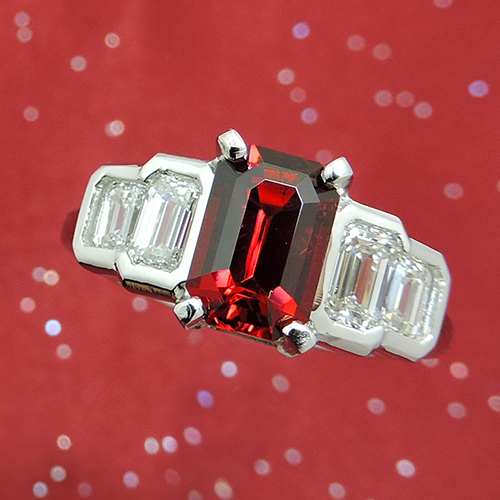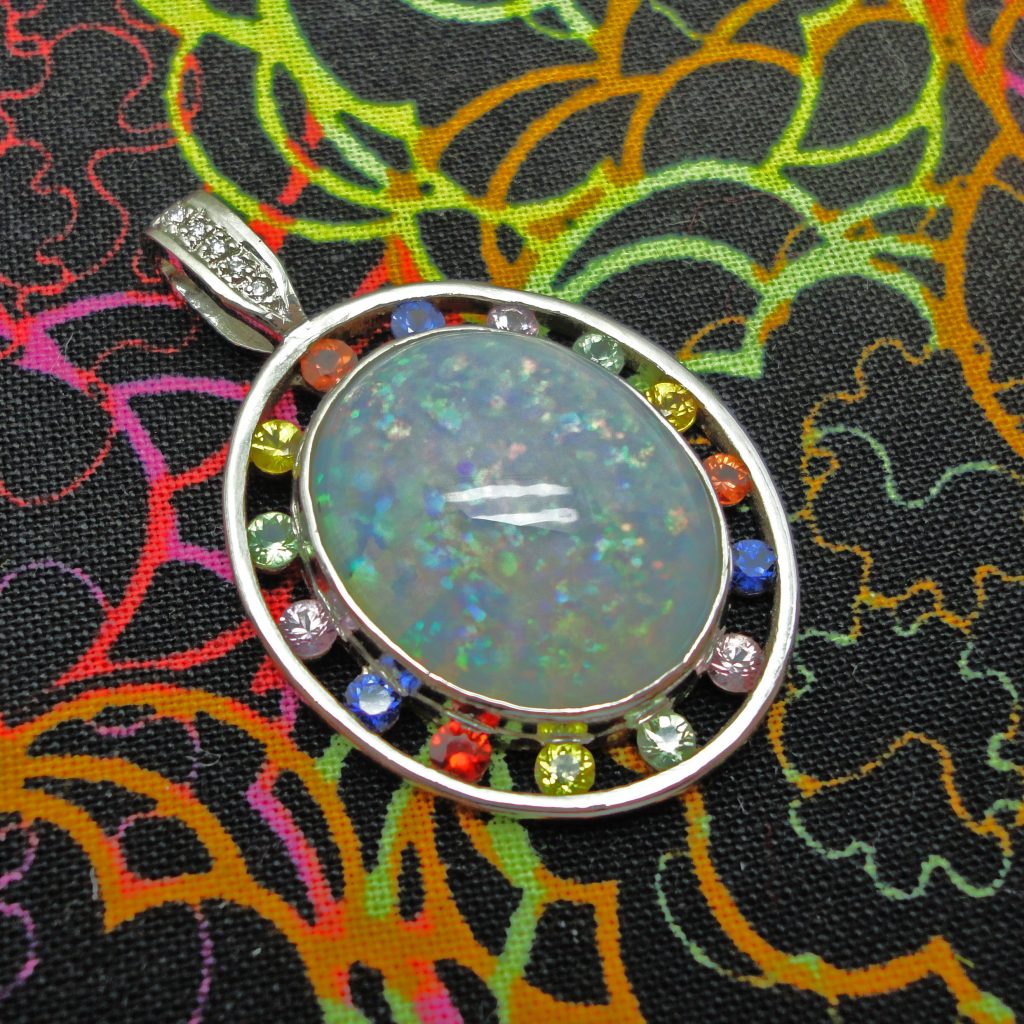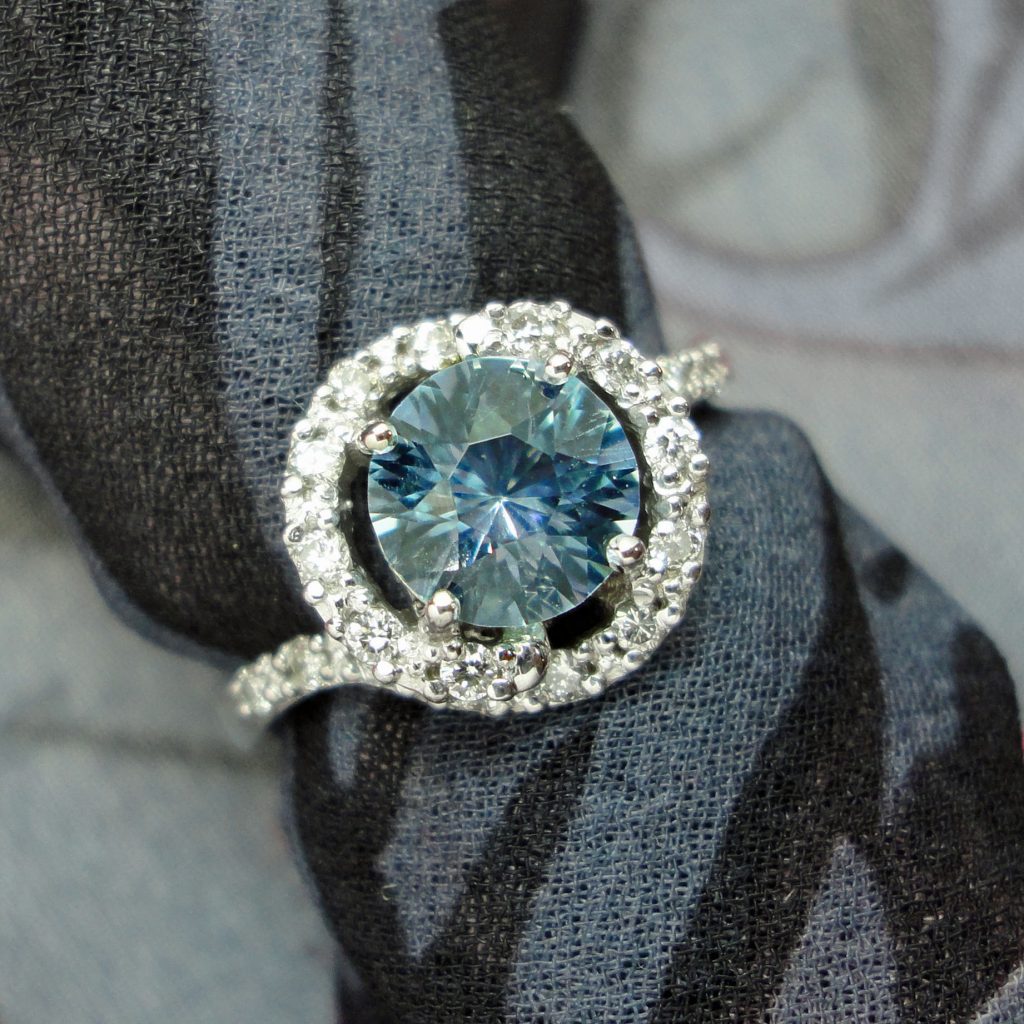Breathtaking beauty, sparkle, and color… Gemstones are the heart and soul of fine jewelry.
Minerals, Gemstones, and Jewels
According to the International Gem Society (IGS), gemstones are defined as: “Minerals that have been chosen for their beauty and durability, then cut and polished for use as human adornment.” Many of the minerals classified as gemstones are crystalline in nature, perhaps because crystals are naturally sparkly.
Of course, these mineral gemstones aren’t the only gems prized for their beauty and rarity. Natural amber and pearls are also classified as gemstones even though they are organics rather than minerals. As gemologist Donald Clark, founder of the International Gem Society, says, “If it makes your eyes light up, it’s a true gem!”
There are more than 2,000 different kinds of minerals found worldwide and fewer than 100 of them are considered gemstones. Of those, only 16 are commonly used in jewelry making. As if rubies, emeralds, and diamonds could ever be considered common!
There are more than just 16 gemstones available. That’s because some mineral ‘species’ produce more than one gemstone. For instance, corundum produces both rubies and sapphires. With so many beautiful gemstones to choose from, you’re sure to find one with the color, brilliance, clarity, size, durability, and cut you want for a piece of custom jewelry.
Designing Jewelry with Gemstones
There are several factors that weigh on the decision-making process when designing jewelry. We’ll touch on those factors below.
Hardness and Durability
When designing jewelry, it’s important to take a gemstone’s hardness into account. Delicate pearls are generally used in earrings and necklaces where they’re better protected from everyday bangs and rubs than they would be in a ring or bracelet. The same is true of amber, opal, and even turquoise, which is commonly encased in silver when worn in bracelets in order to protect it from damage.
A durable gemstone is both hard and tough. A gemstone that is hard without also being tough could shatter like glass if struck hard enough. Garnets, rubies, and sapphires possess both qualities and are suitable for any kind of jewelry.
Choosing harder, more durable gemstones for jewelry like bracelets, rings, and cufflinks that are subject to wear and tear when worn will ensure that these pieces will retain their beauty for many years to come.
Color
Besides a gemstone’s durability, color is probably the most important consideration when choosing the stones for your custom jewelry. Fortunately, from sparkling clear diamonds to shimmering black pearls, gemstones are available in a wide range of gorgeous colors!
Besides clear and black, there is a whole rainbow of whites, yellows, peaches, oranges, pinks, reds, greens, blues, purples, browns, grays, and silver gemstones. There are also multicolored gemstones that combine two or more different colors in a single stone.
Factors affecting a gemstone’s color:
– Hue is the color of the stone.
– The tone is its lightness or darkness.
– Saturation is the purity or intensity of the hue.
Every gemstone has an optimal hue, tone, and saturation. It can be difficult for buyers to discern the subtle differences between stones.
Look at several similar unset gemstones and choose the one that draws your eye the most. That’s the one that you’ll be the most pleased with and will enjoy wearing for years to come.
List of common gemstones by color:
- Colorless, White, or Silver – Achroite (Tourmaline), Agate (Chalcedony), Beryl, Calcite, Danburite, Diamond, Goshenite (Beryl), Rainbow Moonstone, Opal, Quartz, Sapphire (Corundum), Silver Topaz, Spinel, Star Quartz, White Spinel, White Sapphire, Tourmalinated Quartz, Zircon, Spodumene, Pearl, Labradortite Feldspar, Goshenite, Scapolite.
- Yellow – Ametrine (Quartz), Beryl, Cat’s Eye (Chrysoberyl), Citrine (Quartz), Champagne Citrine, Chrysoberyl, Corundum, Cymophane (Chrysoberyl), Golden Beryl, Golden Sapphire, Golden Tourmaline, Lemon Jade, Lemon Yellow Citrine, Sphalerite, Scapolite, Sphene (Titanite), Topaz, Titanite, Sphene (Titanite), Yellow Sapphire, Yellow Tourmaline, Zircon, Idocrase, Andalusite, Amber.
- Peach – Peach Beryl, Corundum, Imperial Topaz, Moonstone, Padparadscha (Sapphire), Peach Moonstone, Precious Topaz, Topaz, Spinel.
- Orange – Ametrine (Quartz), Cachemirine Garnet, Citrine (Quartz), Clinohumite, Garnet, Corundum, Flourite, Golden Tourmaline, Golden Sapphire, Grossular Garnet, Hessonite (Garnet), Malaya Garnet, Mandarin Garnet, Mexican Fire Opal, Orange Beryl, Orange Tourmaline, Poppy Topaz, Sapphire (Corundum), Topaz, Spessartine Garnet, Tourmaline, Carnelian (Chalcedony).
- Pink – Beryl, Corundum, Imperial Garnet, Kunzite (Spodumene), Morganite (Beryl), Pink Diamond, Pink Sapphire, Pink Spinel, Pink Tourmaline, Precious Topaz Quartz, Rhodochrosite, Rhodonite, Topaz, Spinel, Tourmaline, Topaz, Spodumene, Parti-Colored (Tourmaline), Unakite, Thulite (Zoisite), Rose Quartz.
- Red – Almandite (Garnet), Red Beryl, Chalcedony (Quartz), Madeira Citrine, Garnet, Ruby (Corundum), Sapphire (Corundum), Sardonyx (Chalcedony), Spessartine Garnet, Spinel, Thai Garnet, Topaz, Tourmaline, Zircon.
- Green – African Jade, Alexandrite (Chrysoberyl), Amazonite, Andalusite, Andradite Grossular (Garnet), Aventurine (Quartz), Azurite-Malachite, Beryl, Cat’s Eye Enstatite, Chalcedony (Quartz), Chrome Diopside, Chrome Tourmaline, Diopside, Emerald (Beryl), Enstatite, Flourite, Green Beryl, Green Moonstone, Green Quartz, Green Sapphire, Green Topaz, Green Tourmaline, Grossular Garnet, Hiddenite (Spodumene) Idocrase, Jade, Malachite, Moss Agate, Moldavite (Tektite), Nephrite (Jade), Prasiolite (Quartz), Rainforest Topaz, Sea Jasper, Seraphinite, Sphene (Titanite), Spodumene, Titanite, Tourmaline, Zircon, Jadite, Uvarovite (Garnet), Kornerupine, Peridot, Tsavorite (Garnet), Chrysoberyl, Trapiche Emerald (Beryl).
- Blue – American Blue Topaz, Apatite, Aqua Blue Chalcedony, Aquamarine (Beryl), Azurite, Beryl, Benitoite, Blue Diamond, Blue Sapphire, Blue Moonstone, Blue Mist Chalcedony, Blue Spinel, Blue Topaz, Corundum, Flourite, Indicolite (Tourmaline), Iolite, Kyanite, London Blue Topaz, Sky Blue Topaz, Swiss Blue Topaz, Tanzanite (Zoisite), Teel Topaz, Zircon, Turquoise, Lapis Lazuli.
- Purple – Amethyst (Quartz), Ametrine (Quartz), Charoite, Color change Sapphire, Corundum, Garnet, Purple Garnet, Violet Sapphire, Violet Spinel, Water Sapphire (Iolite), Charoite, Sugilite, Alexandrite, Tanzanite (Zoisite), Lavender Jade.
- Brown – Agate (Chalcedony), Fire Agate, Malaya Garnet, Quartz, Malaya Garnet, Tiger’s Eye Quartz, Wild Horse Jasper.
- Grey – Grey Moonstone, Grey Quartz, Hematite, Grey Star Sapphire, Spinel.
- Black – Black Diamond, Black Lace Onyx, Black Onyx, Black Opal, Black Spinel, Black Tourmaline, Spinel, Tourmalinated Quartz, Sardonyx, Snowflake Obsidian, Nephrite, Hematite, Pyrite.
- Multi-Color – Agate (Chalcedony), Alexandrite (Chrysoberyl), Ametrine (Quartz),Azurite-Malachite, Bi-Color Quartz, Bi-Color Sapphire, Bi-Color Tourmaline, Black Opal, Bloodstone (Chalcedony), Bluebird (Azurite-Cuprite), Fire Agate, Flourite, Labradorite, Mexican Jelly Opal, Moonstone, Moss Agate, Mystic Fire Topaz, Opal, Tourmaline, Polka dot Jasper, Andalusite.
Clarity
A gemstone’s clarity affects how light moves through it. Inclusions block or divert the light, changing how the gem looks from different angles. Of course, not all inclusions are faults! Some gemstones are actually more valuable because of inclusions. This is true of those rare pieces of amber that contain a tiny insect or leaf inside.
Other valuable gemstone inclusions are the rutiles (titanium dioxide crystals) that form the delicate golden needle patterns inside rutilated quartz. When rutile needles align just right, they produce the star patterns (asterism) or moving cat’s eyes (chatoyancy) that make star sapphires or rubies and cat’s eye chrysoberyl so valuable.
Some gemstones are prized even though they aren’t transparent or even translucent. Turquoise, opal, lapis lazuli, jade, and pearls are all opaque gemstones that are valuable despite their lack of clarity.
Weight
Carat weight is the standard for weighing gemstones. One carat is equivalent to 0.2 grams. The dimensions of colored gemstones are also measured in millimeters to make it easier to match stones for earrings or other pieces.
Enhancements
The color, clarity, and beauty of many colored gems are enhanced or treated through the use of chemicals (hydrogen peroxide), diffusion (heating with additions), dyeing, filling, heat treating, irradiation, or oiling.
Of course, natural (untreated) gemstones of similar size and appearance are always more valuable than enhanced stones. That’s why, ethically and legally, sellers are required to accurately and fully describe any treatment a gemstone has undergone.
Facet Cuts Bring Out the Sparkle
Choosing the perfect gemstones for your custom jewelry is only the first step. The next step is choosing a cut you love that also brings out the sparkling best in each stone. With 30 different standard facet cuts available, as well as custom faceting diagrams and formulas that add another 500 unique cutting options, we’re sure to have a perfect facet design that will let you and your gemstones shine!
The result of choosing the perfect stones and having them expertly cut and set is a piece of exquisite jewelry with a personality as unique as your own. Contact Revolution Jewelry Works for professional guidance in choosing the gemstone, cut, and setting that will make your next piece of custom jewelry a treasured future heirloom.


